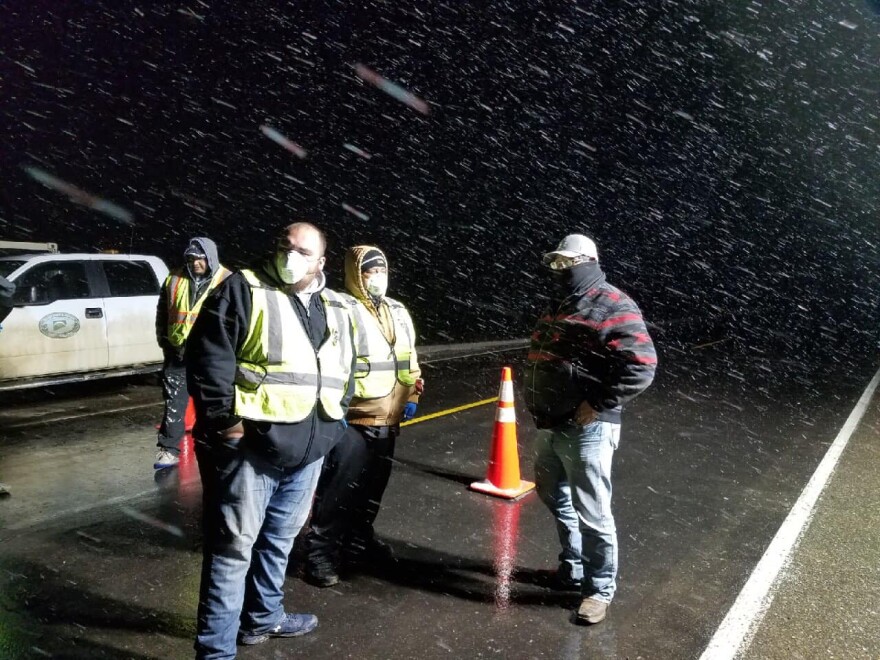Over the last couple of months, the streets of Rapid City seemed all but dead – save a few stragglers here and there – due to people self-quarantining.
Even though June is supposed to be the state’s peak in confirmed cases, South Dakota and her cities and towns are relaxing their COVID-19 restrictions to get “Back to Normal.”
While that’s happening, places like the Cheyenne River Sioux Tribe (CRST) are maintaining their status quo.
Back in April, tribal leadership established health checkpoints that restricted travel. Non-residents who are non-essential are turned away, while residents and essential non-residents must fill out a health questionnaire.
“We had two positive cases and because of these checkpoints we do know when the patients left, we know where they were and we know when they came back,” said CRST Tribal Chairman Harold Frazier.
He says these health checkpoints are the tribe’s first line of defense against the virus. He fears if they weren’t in place, the virus can quickly spread between communities on the reservation. He only has to look south to see the damage.
“Just looking at Navajo and what’s going on down there, that’s our concern,” said Frazier. “It seems we have a very high [of] what they deem vulnerable population. You know all the health disparities that goes on in Indian Country and we can go on-and-on on why, but the bottom line is it could easily happen to us.”
The Navajo Nation is one of the largest reservations in the United States, as of June 3, they have recorded a total of 5,661 confirmed cases. Frazier says one the main reasons it spreads so fast is because the stark contrast of how life on the reservation is compared to the rest of the state and nation.
“Definitely one of the things that I always point out is that the living conditions of our people are not like mainstream South Dakota or America, where you have 2-3 people or five people at the most, everyone has their own bedroom,” said Frazier. “It’s usually 12 to 20 people in a house, 2-3 families share a bedroom because there isn’t enough housing available for our people.”
The tribe has also made precautions so that no one will go hungry during the pandemic.
“We were really fortunate, you know we do have a buffalo herd, elk herd, we do have a cattle ranch, the tribe does but one of the things that we are really, really proud about is a lot of our ranchers stepped up and each one has, there has probably been about 60 of them that has donated a beef to the tribe. So we been processing them, storing them and just ready for whatever may need to happen. That was one of the main things at the very beginning was making sure that our people wouldn’t go without food, so we’ve been storing that. I think we are over 10,000 pounds of hamburger waiting. “
Recently, Gov. Kristi Noem threatened legal action against Cheyenne River Sioux Tribe and the Oglala Sioux Tribe for their use of checkpoints. She has not followed through on that threat, but Chairmen Frazier says if it weren’t for their checkpoints, nothing would have gotten done in the first place.
“I believe that the BIA (Bureau of Indian Affairs), the government has a trust responsibility and they haven’t really stepped up like I feel they should of and because they won’t step up, it forces us to,” said Frazier, “so if we’re going to step up, we’re going to do it our way. If they would have been doing all these things, we wouldn’t have to be doing checkpoints and things like that, but you know we can’t wait for them.”
Fighting to keep his people safe from the coronavirus pandemic is at the forefront of Frazier’s mind, otherwise he remains hopeful.
“…every day I remind people to be patient and stay positive and we need to stay united and we need to stay strong in our prayers,” said Frazier. “We do all these things and we will be able to get by a lot easier than what it is.”
Frazier says he hopes someday there is a vaccine. He says until then he will keep the checkpoints and the status quo to keep people safe on the reservation.


